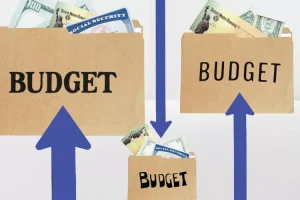
Building wealth takes time, effort, and discipline. The good news is that there are strategies that can help anyone build and preserve wealth over the long term. The earlier you start putting these into practice, the better your chances of success.
Below, we have outlined several key principles for building wealth, including setting goals, managing debt, saving and investing, understanding the impact of taxes, and building a strong credit history. Let’s take a closer look at each of these principles and how they can help you achieve your financial goals.
▼KEY TAKEAWAYS
- Building wealth over time requires an understanding of how to invest wisely, safeguard assets, and manage debt.
- The first step is to earn enough money to cover your basic needs, with some left over for saving.
- To create a financial plan, consider your personal goals, which may include buying a home, saving for retirement, or putting your kids through college.
- Diversifying your investments will help protect your money from market downturns.
1. Earn Money
The first thing you need to do is start making money. This step might seem obvious, but it’s essential—you can’t save what you don’t have. You’ve probably seen charts showing that a small amount of money regularly saved and allowed to compound over time eventually can grow into a substantial sum. But those charts never answer this basic question: How do you get money to save in the first place?
There are two basic ways of making money: through earned income or passive income. Earned income comes from what you do for a living, while passive income comes from investments. You probably won’t have any passive income until you’ve earned enough money to begin investing.
If you are either about to start a career or contemplating a career change, these questions may help you decide on what you want to do—and where your earned income is going to come from:
- 1.What do you enjoy? You will perform better, build a longer-lasting career, and be more likely to succeed financially by doing something that you enjoy and find meaningful. In fact, one study found that more than nine out of 10 workers said they would trade a percentage of their lifetime earnings for greater meaning at work.
- 2.What are you good at? Think about what you do well and how you can use those talents to earn a living.
- 3.What will pay well? Look at careers using what you enjoy and do well that will meet your needs. One good source of salary information and growth prospects for various fields is the Occupational Outlook Handbook published by the U.S. Bureau of Labor Statistics.
- 4.How do you get there? Learn about the education, training, and experience requirements to pursue your chosen career options. The Occupational Outlook Handbook has information on this, too.
Taking these considerations into account can help put you on the right path.
★Tips:
Investing in your education and skills is an excellent way to maximize your earning potential. Advanced degrees, industry-specific certifications, and training programs are all helpful in building your human capital. Just be sure to consider student loan debt in your calculations to be sure that your investment will pay off.
2. Set Goals and Develop a Plan
What will you use your wealth for? Do you want to fund your retirement—maybe even an early retirement? Pay for your kids to go to college? Buy a second home? Donate your wealth to charity? Setting goals is an essential step in building wealth. When you have a clear vision of what you want to achieve, you can create a plan to help you get there.
Start by defining your financial goals, such as saving for retirement, buying a home, or paying off debt. Be specific about how much money you need to achieve each goal and the time frame you hope to achieve it.
Once you have set your goals, you should develop a plan for achieving them. This may involve creating a budget to help you save more money, increasing your income through education or career advancement, or investing in assets that will appreciate in value over time. Your plan should be realistic, flexible, and focused on the long term. Regularly review your progress and adjust as needed to keep yourself on track.
3. Save Money
Simply making money won’t help you build wealth if you end up spending it all. Moreover, if you don’t have enough money for your bills or an emergency, you should prioritize saving enough above all else. Many experts recommend having three to six months’ worth of income saved up for such situations.
To set more money aside for building wealth, consider these moves:
- 1.Track your spending for at least a month. You can use a budgeting app or spreadsheet to help you do this, but a small, pocket-size notebook could also work. Record what you spend, even small amounts; many people are surprised to see where all their money goes.
- 2.Find the fat and trim it. Break down your expenditures into needs and wants. Food, shelter, and clothing are obvious needs. Add health insurance premiums to that list, auto insurance if you own a car, and life insurance if other people depend on your income. Many other expenditures will merely be wants.
- 3.Set a savings goal. Once you have a reasonable idea of how much money you can set aside each month, try to stick to it. This doesn’t mean that you have to live like a miser or be frugal all the time. If you’re meeting your savings goals, feel free to reward yourself once in a while. You’ll feel better and be motivated to stay on course.
- 4.Put saving on automatic. One easy way to save is to set up automatic transfers through your employer or bank. Pick a set amount of your paycheck each month and have it transferred to your savings or investment account. Similarly, you can save for retirement by having money automatically withdrawn from your pay and put into your employer’s 401(k). Financial planners usually advise contributing at least enough to get your employer’s full matching contribution.
- 5.Find high-yield savings. Maximize the payoff of your savings by shopping for savings accounts with the highest interest rates and lowest fees. High-yield savings accounts (HYSAs) offer 10 to 12 times the interest rate of a standard savings account. Certificates of deposit (CDs) can be a good savings option if you can afford to lock up that money for several months or years.
Keep this in mind, too: You can only cut so much in costs. If your costs are already down to the bone, you should look into ways to increase your income.
▼Important:
One of the best ways to be sure you are saving enough is to set a spending budget. Cut back on excess and unnecessary spending and put that money in the bank instead.
4. Invest
Once you’ve managed to set aside some money, the next step is investing it so that it will grow. Remember that interest rates on typical savings accounts tend to be very low, and your cash risks losing purchasing power over time to inflation.
Perhaps the most important investing concept for beginners (or any investor, for that matter) is diversification. Simply put, your goal should be to spread your money among different types of investments. That’s because investments perform differently at different times. For example, bonds may provide good returns if the stock market is on a losing streak. Or if Stock A is in a slump, Stock B may be on a tear.
Perhaps the most important investing concept for beginners (or any investor, for that matter) is diversification. Simply put, your goal should be to spread your money among different types of investments. That’s because investments perform differently at different times. For example, bonds may provide good returns if the stock market is on a losing streak. Or if Stock A is in a slump, Stock B may be on a tear.
As another general rule, the younger you are, the more risk you can afford to take because you’ll have more years to make up for any losses.
★Tips:
Index funds, such as you’ll find in your employer’s 401(k) or your IRA, are a type of mutual fund or ETF. These funds typically have lower fees than actively managed funds, making them a good entry point for new investors.
Types of Investments
Investments vary in terms of risk and potential return. Generally, the safer they are, the lower their potential return, and vice versa.
If you aren’t already familiar with the various types of investments, it’s worth spending a little time reading up on them. While there are all kinds of exotic investments, most people will want to start with the basics: stocks, bonds, and mutual funds.
- Stocks are shares of ownership in a corporation. When you buy stock, you own a tiny slice of that company and will benefit from any rise in its share price and any dividends it pays out. Stocks are generally considered riskier than bonds, but stocks can also vary widely in risk from one corporation to another.
- Bonds are like IOUs from a company or government. When you buy a bond, the issuer promises to pay your money back, with interest, after a certain period. Bonds are considered less risky than stocks but with less potential upside. At the same time, some bonds are riskier than others; bond-rating agencies assign them letter grades to reflect that.
- Mutual funds are pools of securities—often stocks, bonds, or a combination of the two. When you buy mutual fund shares, you get a slice of the entire pool. Mutual funds also vary in risk, depending on what they invest in.
- Also, exchange-traded funds (ETFs) are like mutual funds in that each share holds an entire portfolio of securities, but ETFs are listed on exchanges and trade like stocks. Some ETFs track major stock indexes like the S&P 500, particular industry sectors, or asset classes like bonds and real estate.
▼Warning:
Before you start investing, make sure you have sufficient savings and some money set aside to handle any unexpected financial emergencies.
5. Protect Your Assets
You’ve worked hard to earn your money and grow your wealth. The worst thing could be to lose it all due to a sudden tragedy or unforeseen event. Insurance is key to building your wealth because it protects you from hazards. Home insurance will replace your home and belongings in case of a fire, auto insurance will make you whole after a car accident, and life insurance will pay your beneficiaries a death benefit in the case of an untimely death.
Long-term disability insurance is another type of policy that will replace your income if you become injured, ill, or otherwise incapacitated and unable to continue working. Even young, healthy people should consider insurance products since they tend to become more expensive as you grow older. That means even if you are 25 years old and single, buying life insurance could be much more cost-effective than when you are 10 years older with a partner, children, and mortgage.
6. Minimize the Impact of Taxes
Taxes are an often-overlooked drag on your wealth-building efforts. Of course, we are all subject to income tax and sales tax as we earn and spend money, but our investments and assets can also be taxed. That’s why it is essential to understand your tax exposures and develop strategies to minimize their impact.
Investing in tax-advantaged accounts is one easy way to minimize your tax bill. These accounts, such as 529 college savings plans, individual retirement accounts (IRAs), and 401(k) plans, offer tax benefits that can help you save more money and reduce your tax bill. For example, contributions to a traditional IRA or 401(k) are tax-deductible, meaning you can reduce your taxable income and save money on taxes in the year when you make the contribution. Also, they grow tax-deferred, meaning that the impact will be smaller when you retire and are more likely to be in a lower tax bracket. Investment gains in a Roth IRA or Roth 401(k) are tax-exempt, meaning that you can grow and withdraw money in a Roth account without paying taxes on any of the income or gains.
Another strategy for minimizing taxes is to be mindful of the timing and location of your investments. By holding investments for more than a year, you can take advantage of the lower long-term capital gains tax rate, which is generally lower than the short-term capital gains tax and income tax rates.
Also, keep in mind where certain assets are held. Given a choice, an income-producing asset like a dividend-paying stock or corporate bond should be placed in a tax-advantaged account like a Roth IRA, where these payments will not trigger taxable events. A growth stock that will only produce capital gains (rather than income) might be better located in a taxable account.
★Tips:
Consider talking with a qualified tax professional, such as an accountant or a certified public accountant (CPA), who can help you develop a tax strategy for your specific financial situation. By minimizing the impact of taxes, you can build wealth more effectively and preserve more of your hard-earned money over the long term.
7. Manage Debt and Build Your Credit
As you build wealth, you’ll start to find it worthwhile to take on debt to fund various purchases or investments. You may pay for things with a credit card to earn points or rewards. You might apply for a mortgage for a home or second home, a home equity loan for home improvements, or an auto loan to purchase a car. Maybe you’ll want to take out a personal loan to help start a business or invest in someone else’s.
However, it’s important to manage your debt carefully—taking on too much debt could impede your progress toward your wealth-building goals. To manage debt, be mindful of your debt-to-income (DTI) ratio and make sure that your debt payments are manageable within your budget. You should also aim to pay off high-interest debt, such as credit card debt, as quickly as possible to avoid paying excessive interest charges. Be wary of variable or adjustable interest rate products like adjustable-rate mortgages (ARMs) or those with balloon payments, as changes to the economy or your personal circumstances can quickly cause those debts to become unmanageable.
Indeed, if you fall into debt, your credit score can be negatively impacted, and if you default on your debts, you could face personal bankruptcy.
Maintaining a Good Credit Score
Building and maintaining a good credit score is an important part of growing and preserving your wealth over the long term. You’ll enjoy a lower interest rate and better terms on your loans if you have a strong credit history and high credit score, which can save you thousands of dollars in interest charges over time
Here are a few key steps that you can take to maintain a good credit score:
- 1.Pay your bills on time. One of the most important factors that affect your credit score is your payment history. To maintain a good credit score, you should make sure to pay your bills on time, every time. Late payments, even if they’re only a few days late, can have a significant negative impact on your credit score.
- 2.Keep your credit utilization low. Your credit utilization, or the amount of credit you’re using compared to the amount you have available, is another important factor that affects your credit score. To maintain a good credit score, you should aim to keep your credit utilization below 30% of your available credit.
- 3.Monitor your credit report. It’s a good idea to check your credit report regularly to make sure that all the information is accurate and up to date. Today, several services will provide you with a credit report free of charge. Errors on your credit report can negatively impact your credit score, so it’s important to dispute any inaccuracies you find.
- 4.Avoid opening too many new accounts. Every time you apply for credit, it can have a slight negative impact on your credit score. To maintain a good credit score, you should avoid opening too many new accounts in a short period of time. Note, however, that if you do not use credit cards or don’t have enough credit lines open, you may fall victim to having an insufficient credit history. So, open some credit cards and take out some loans, but do not overdo it.
By following these steps and practicing good credit habits, you can maintain a good credit score and maximize your borrowing power over the long term.
Should I Pay Off Debt or Invest?
If you have high-interest debt, such as many credit card charges, it usually makes sense to pay it off before you invest. Few investments ever pay as much as credit cards charge. Once you’ve paid off your debt, redirect that extra money to savings and investments. And try to pay your credit card balance in full each month, whenever possible, to avoid owing interest in the future.
How Much Money Do I Need To Buy a Mutual Fund?
Mutual fund companies have different minimum initial investment requirements to get started, often beginning at about $500. After that, you can usually invest less. Some mutual funds will waive their initial minimums if you commit to investing a regular sum each month. You can also buy mutual fund and exchange-traded fund (ETF) shares through a brokerage firm, some of which charge nothing for opening an account.
What Is an Exchange-Traded Fund (ETF)?
Exchange-traded funds (ETFs) are investment pools much like mutual funds. A key difference is that their shares are traded on stock exchanges (rather than bought and sold through a particular fund company). They sometimes charge lower fees as well. You can also buy them, along with stocks and bonds, through a brokerage firm.
The Bottom Line
While get-rich-quick schemes sometimes may be enticing, the tried-and-true way to build wealth is through regular saving and investing—and patiently allowing that money to grow over time. It’s fine to start small. The important thing is to start and to start early. Earn money and then save and invest it smartly. Protect your assets with insurance and minimize your tax exposure.
Remember, building wealth is a journey, not a destination. Celebrate your successes along the way, and don’t get discouraged by setbacks or obstacles. With patience, discipline, and a clear vision of your goals, you can achieve financial success and build wealth over the long term.
Personalized Advice When You Need It
Put your financial goals in motion with an expert-built portfolio and receive ongoing advice and annual check-ins to ensure your plan is on track. With J.P. Morgan Personal Advisors, you can get a professionally designed investment portfolio that meets your needs and automatically rebalances as the market shifts. Fill out this short form to get started.





